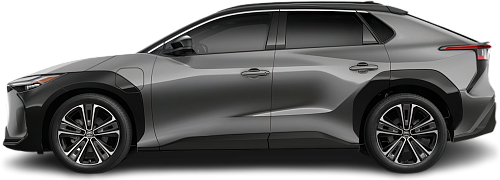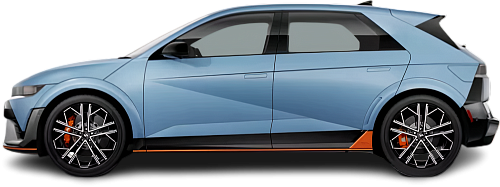Global EV Comparison: Toyota bZ4X (bZ) FWD vs Hyundai Ioniq 5 N
Struggling to Decide? Let AI Help!
Your AI Summary Is Ready!
General Info
The Hyundai Ioniq 5 N (2023-…) is currently produced, it has a starting price of €75560. The Toyota bZ4X FWD (2022-2025) has been discontinued. You can find it for as low as €29990 on the used car market.
The two vehicles share the same body style: SUV.
| Property | Toyota bZ4X (bZ) FWD | Hyundai Ioniq 5 N |
|---|---|---|
| Years of Production | 2022-2025 | 2023-… |
| Current Status | Discontinued | Produced |
| Country of Manufacture | Japan, China | Indonesia, Singapore, South Korea |
| Body Style | SUV | SUV |
| Market Availability | EU, USA | EU, USA |
| Price Europe (New) | - Price Europe (New) | €75560 |
| Price Europe (Used) | €29990 | €56499 |
| GCC Score | 6.1 | 6.8 |
Range and Efficiency
Even though the Hyundai Ioniq 5 N (2023-…) has a larger battery, the Toyota bZ4X FWD (2022-2025) higher energy efficiency results in a longer real-world driving range.
| Property | Toyota bZ4X (bZ) FWD | Hyundai Ioniq 5 N |
|---|---|---|
| Range (EPA) | 406 km | 356 km |
| Range (WLTP) | 516 km | 450 km |
| Range (GCC) | 407 km | 360 km |
| Battery Capacity (Nominal) | 71.4 kWh | 84 kWh |
| Battery Capacity (Usable) | 64 kWh | 80 kWh |
| Efficiency per 100 km | 15.7 kWh/100 km | 22.2 kWh/100 km |
| Efficiency per kWh | 6.36 km/kWh | 4.5 km/kWh |
| Range and Efficiency Score | 7.6 | 4.9 |
Charging
The Hyundai Ioniq 5 N (2023-…) features an advanced 800-volt architecture, whereas the Toyota bZ4X FWD (2022-2025) relies on a standard 400-volt system.
The Hyundai Ioniq 5 N (2023-…) offers faster charging speeds at DC stations, reaching up to 240 kW, while the Toyota bZ4X FWD (2022-2025) maxes out at 150 kW.
The Hyundai Ioniq 5 N (2023-…) features a more powerful on-board charger, supporting a maximum AC charging power of 11 kW, whereas the Toyota bZ4X FWD (2022-2025) is limited to 6.6 kW.
| Property | Toyota bZ4X (bZ) FWD | Hyundai Ioniq 5 N |
|---|---|---|
| Max Charging Power (AC) | 6.6 kW | 11 kW |
| Max Charging Power (DC) | 150 kW | 240 kW |
| Architecture | 400 V | 800 V |
| Charge Port | CCS Type 2 | CCS Type 2 |
| Charging Score | 5 | 7.9 |
Performance
The Toyota bZ4X FWD (2022-2025) is front-wheel drive, while the Hyundai Ioniq 5 N (2023-…) offers an all-wheel drive system.
The Hyundai Ioniq 5 N (2023-…) boasts greater motor power and accelerates faster from 0 to 100 km/h.
| Property | Toyota bZ4X (bZ) FWD | Hyundai Ioniq 5 N |
|---|---|---|
| Drive Type | FWD | AWD |
| Motor Type | PMSM | PMSM (front), PMSM (rear) |
| Motor Power (kW) | 150 kW | 478 kW |
| Motor Power (hp) | 201 hp | 641 hp |
| Motor Torque | 266 Nm | 740 Nm |
| 0-100 km/h | 7.5 s | 3.4 s |
| Top Speed | 160 km/h | 260 km/h |
| Performance Score | 3.4 | 7.2 |
Dimensions
The Hyundai Ioniq 5 N (2023-…) is wider, but has a similar length and height to the Toyota bZ4X FWD (2022-2025).
The Hyundai Ioniq 5 N (2023-…) boasts a more extended wheelbase.
| Property | Toyota bZ4X (bZ) FWD | Hyundai Ioniq 5 N |
|---|---|---|
| Length | 4690 mm | 4715 mm |
| Width (with Mirrors) | - Width (with Mirrors) | 2152 mm |
| Width (w/o Mirrors) | 1860 mm | 1940 mm |
| Height | 1600 mm | 1585 mm |
| Wheelbase | 2850 mm | 3000 mm |
Cargo and Towing
Neither car is equipped with a frunk (front trunk).
The Toyota bZ4X FWD (2022-2025) has a towing capacity of up to 750 kg, whereas the Hyundai Ioniq 5 N (2023-…) is not officially rated for towing in the EU.
| Property | Toyota bZ4X (bZ) FWD | Hyundai Ioniq 5 N |
|---|---|---|
| Number of Seats | 5 | 5 |
| Curb Weight | 1910 kg | 2275 kg |
| Cargo Volume (Trunk) | 452 l | 480 l |
| Cargo Volume (Max) | - Cargo Volume (Max) | 1540 l |
| Cargo Volume (Frunk) | - Cargo Volume (Frunk) | - Cargo Volume (Frunk) |
| Towing Capacity | 750 kg | - Towing Capacity |
| Cargo and Towing Score | 6.6 | 6.3 |




